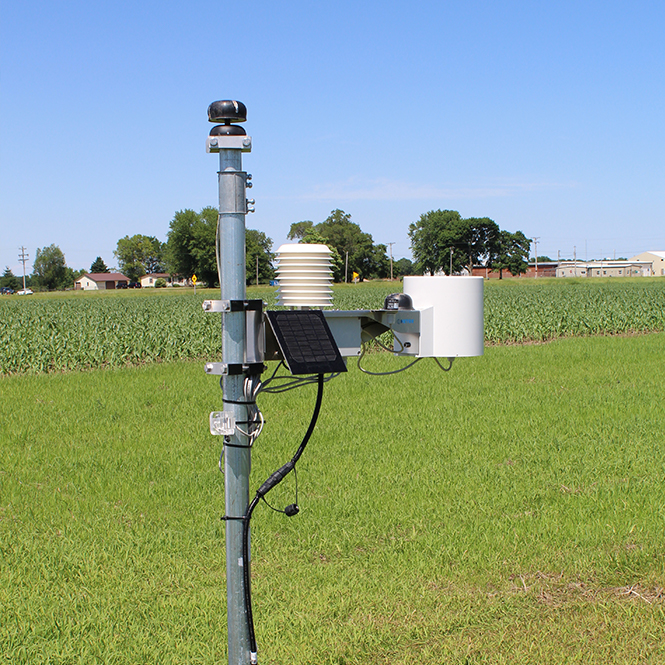品质至上,客户至上,您的满意就是我们的目标
应用案例
当前位置: 首页 > 应用案例
Pessl应用案例-可持续的马铃薯作物-早疫病管理的现场评估
发表时间:2022-03-23 10:54:31点击:1273
来源:北京博普特科技有限公司
分享:

热点
长期潮湿和高温有利于链格孢菌的数量。
AUDPC和r-AUDPC在品种间表现出对疾病的易感性差异。
LO和FB是对链格孢菌最具抗性的品种。
流行病学、空气生物学数据和DSS改善了对早疫病的预测。
摘要
马铃薯作物易受多种田间病害的影响,造成品质和块茎产量的显著损失。控制措施会对土壤和水资源产生负面影响,也会影响农民的健康和粮食安全。因此,更可持续的农业管理是保护生态系统的需要。因此,本研究的目的是在西班牙西北部的一个马铃薯产区,利用决策支持系统(DSS)评估九个马铃薯品种(Fleur Blue、Frisia、Fontane、Louisa、Agria、Daifla、Red Pontiac、Kennebec和Desiree)对早疫病的反应。试验设计是根据适合地理区域的疾病风险模型(DSS地块),使用对照地块和喷洒杀菌剂的地块建立的。从最初症状出现到最终衰老,在现场评估疾病等级和严重程度,并计算疾病进展曲线下的面积(AUDPC和r-AUDPC)。还考虑了对引起马铃薯早疫病的主要链格孢菌种(番茄链格孢菌和链格孢菌)和最脆弱物候期的空气生物学监测。根据天气、病害严重程度和块茎产量分析了马铃薯品种的敏感性。具体而言,温度和叶片湿度是对链格孢菌浓度影响最大的气象变量。在AUDPC在自然条件下测量的症状发展中,前一周的分生孢子是影响最大的变量。DSS地块的品种产量高于对照地块。因此,替代性害虫管理策略,特别是害虫评估决策支持系统,对可持续马铃薯生产至关重要。从这个意义上说,整合有关商业品种抗病性、植物物候发育或作物大气周围真菌颗粒的特定信息,可以支持这些系统在不损害块茎产量和环境的情况下进行更好的调整。
关键词
马铃薯链格孢菌,TOMCAST,AUDPC,病严重程度,产量
Looking for a sustainable potato crop. Field assessment of early blight management
Highlights
Long periods of wetness and high temperatures favoured the Alternaria levels.
AUDPC and r-AUDPC showed differences in susceptibility to disease between cultivars.
LO and FB were the most resistant cultivars to the presence of Alternaria.
Epidemiological, aerobiological data and DSS improve the predictions of early blight.
Abstract
Potato crops are susceptible to numerous field diseases causing significant losses in the quality and tuber yield. Control measures have a negative impact in soil and water resources affecting also farmers’ health and food security. Hence, a more sustainable agriculture management is a need to preserve ecosystems. Therefore, the objective of this study was to evaluate the response of nine potato cultivars (Fleur Bleue, Frisia, Fontane, Louisa, Agria, Daifla, Red Pontiac, Kennebec and Desiree) against early blight using a Decision Support Systems (DSS) in a potato-producing area from Northwest Spain. The experimental design was established using control plots and sprayed plots with fungicide according to a disease risk model adapted to the geographical region (DSS plots). Disease rating and severity were evaluated in field from the appearance of the first symptoms to final of senescence and the area under disease progress curve (AUDPC and r-AUDPC) was calculated. Aerobiological monitoring of main Alternaria species responsible potato early blight (Alternaria solani and Alternaria alternata) and the most vulnerable phenological stages were also considered. The susceptibility of the potato cultivars was analyzed based on the weather, severity of the disease and tuber yields. Specifically, temperature and leaf wetness were the meteorological variables that most influenced on the concentration of Alternaria. Conidia accounted for the previous week was the variable that most influenced in development of symptoms measured by AUDPC in natural conditions. Yields in the cultivars of DSS plots were higher than in control plots. Therefore, alternative pest management strategies, and specifically, Decision Support Systems for pest assessment are crucial for sustainable potato production. In this sense, the integration of particular information on disease resistance of commercial cultivars, phenological development of plant, or fungal particles surrounding the crop atmosphere could support these systems for better adjustment without compromising tuber yield and environment.
Keywords
Solanum tuberosum L.Alternaria TOMCAST AUDPC Disease severity
Yield
The meteorological parameters (temperature, relative humidity and leaf wetness periods) were recorded by using a portable weather station iMETOS ® 3.3. (Pessl Instruments, Weiz, Austria) placed at 1.5 m height inside the study field. The records were extracted per hour. The rain data were obtained from the National Weather Service website (National Weather Service Website) positioned 5 km from study plot.